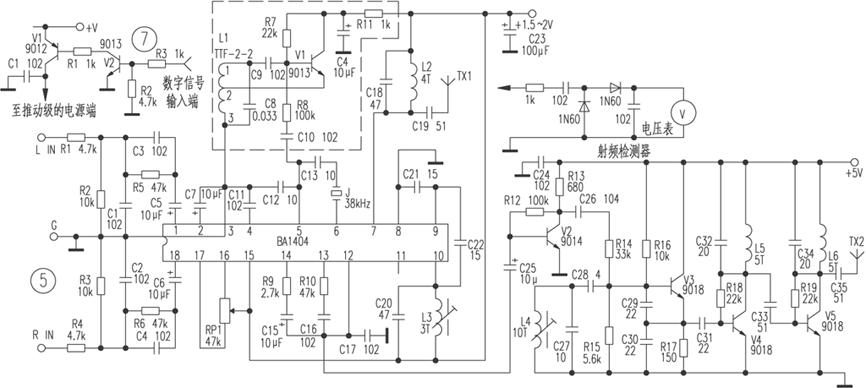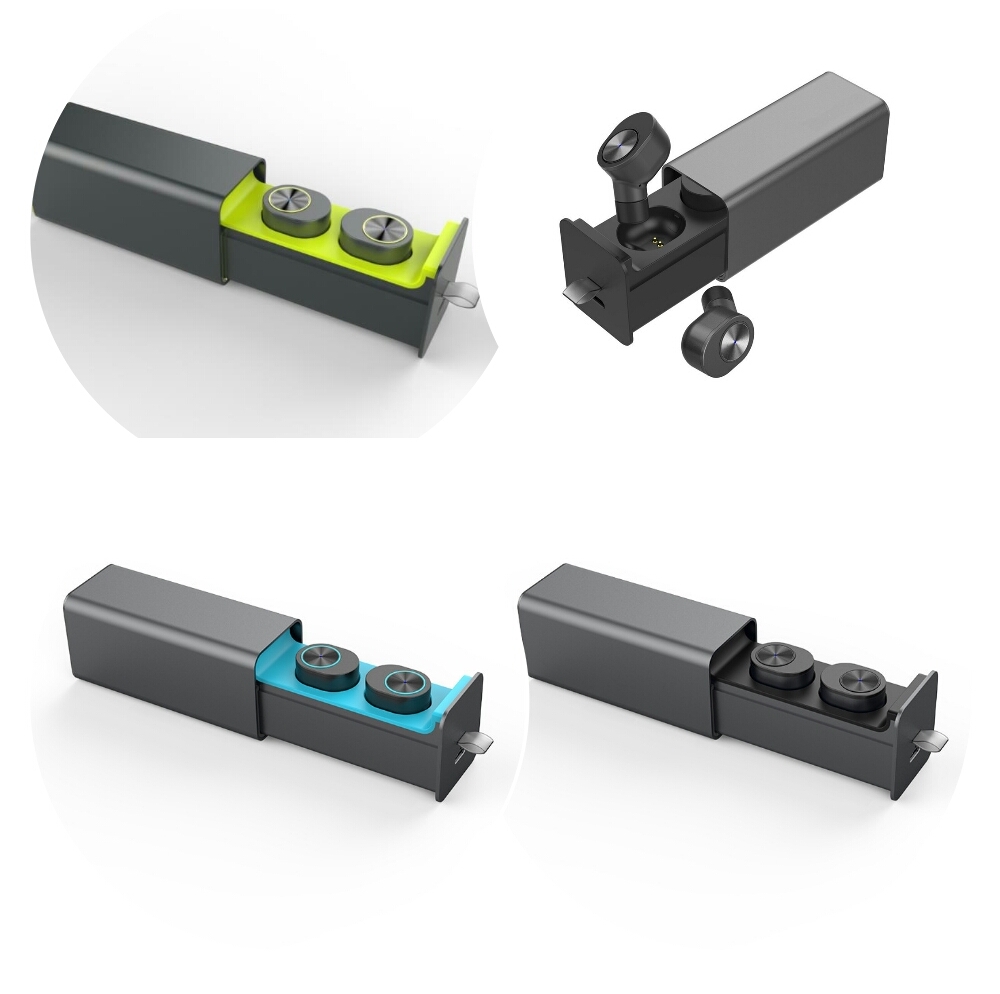Because the 1.5km FM transmitter (see Figure 1 in the previous issue) uses a capacitive three-point oscillator, when the antenna parameters change slightly, frequency running will occur. Furthermore, due to the single-tube self-oscillation emission, the operating current is relatively large. When working for a few seconds to a few minutes, the temperature rise of the transistor causes the capacitance between the poles to change, which also brings about a change in the oscillation frequency (generally, the oscillation frequency is reduced), and sometimes the frequency drift reaches 0.2 to 1MHz. When used as FM broadcast or remote remote alarm, the working reliability is poor, but there are few components, low cost, easy debugging, suitable for junior enthusiasts to launch experiments. The 2km FM transmitter (see Figure 2 in the previous issue) uses three stages of oscillation, frequency doubling, and power amplification. The stages are relatively independent, and the frequency stability is better than the 1.5km transmitter launched by a single-tube self-excited oscillation. After a minute, there is still a frequency drift of 0.2 to 0.4MHz. This is mainly due to the large operating current of V3 and the increase in temperature, which causes a change in the inter-electrode capacitance. This change causes a resonant network composed of C8 and L2 through C9. The parameter changes, and the increase of V2 temperature also causes the parameters of the resonant network composed of C8 and L2 to change. This change is transmitted to the main vibration level composed of C3, C4, L1, C5, C6, V1, etc. through C7, and finally oscillates. The frequency also changes (in general, the oscillation frequency is also reduced). During the experiment, the heat dissipation of the transistor can be strengthened, the coupling between the stages can be reduced, and the capacity of C9 and C7 can be reduced. At the same time, the transistor, resistor, Capacitance, etc., but the frequency drift is still serious. The wireless headset transmitter shown in Figure 3 of the previous issue, due to the use of an improved capacitive three-point oscillator, is more stable in frequency than the transmitter shown in Figures 1 and 2, and the fidelity requirements for TV wireless headsets are not very high. The occasion is very suitable. The crystal oscillator transmitter shown in Figure 4 in the previous issue uses a crystal, so the frequency stability is very good, but when applied to FM broadcasting and Wireless Headphones, the frequency deviation of the modulation is much smaller than that of the LC oscillator. When the volume is low, the sound is not round, and it is generally more suitable for circuits such as cordless phones and walkie-talkies with small frequency deviation.
Acoustic table vibrators have been widely used in various wireless remote control and wireless data transmission equipment transmitters, but acoustic table vibrators with frequencies between 88 and 108MHz are difficult to purchase, and the production of various frequency synthesis transmitters with excellent performance is more troublesome. Interested parties can refer to the article "Analysis of the Modulation Unit Circuit of the Digital Frequency Synthesizer of the TGF-10 FM Broadcast Transmitter", the fifth edition of the "Electronic Newspaper", No. 41, 2000. This broadcast-grade transmitter uses a general Motorola frequency synthesizer. The chip MC145152P is used as the core, and a high stability frequency of 84-108MHz can be obtained through an external DIP switch.
FM stereo transmitter (see Figure 5 for the circuit) The core device of this circuit is the stereo special chip BA1400. Many FM stereo modules are made of BA1404 and peripheral components in a plastic or metal casing, only exposed power input, audio input, RF output leads, as long as you understand BA1400, you will know what is going on inside the FM stereo module .
The stereo audio signal from the audio source is coupled to the BA1440 via a network composed of R1, R2, R5, C1, C3, and C5 (R4, R3, R6, C2, C4, C6). It is amplified by the internal left (right) channel of the IC, and then balanced modulation. The modulated composite signal is output from the {14} pin of the IC, and the pilot signals on the back and the {13} pins pass through R9, C15, R10, The network composed of C16 and C17 is mixed, and the mixed signal after mixing enters the {12} pin of the IC. For the {8}, {9}, and {10} pins of the IC, the capacitive three-point oscillation composed of C20 ~ C22 and L3 The frequency modulation is performed by the device, and the modulated RF signal on the {10} pin of the IC is internally amplified and output from the {7} pin, and then sent to the antenna TX1 after frequency selection by C18 and L2. To achieve FM stereo, BA1404 requires a 38kHz crystal to be connected to the {5} and {6} pins, but it is indeed difficult to purchase a 38kHz special crystal in amateur production, so if there is no such crystal, you can refer to the circuit in the dotted line. Make a 38kHz oscillator with discrete components. The 38kHz signal is sent to IC pin {5} via R8 and C10. At the time of production, L1 can use radio intermediate frequency transformer TTF-2-1, TTF-2-2 or TTF-2-9, etc. At the same time, pay attention to the connection of the pins, the {3} pin is grounded, and the {2} pin is connected to V1 For the emitter, the {1} pin is the feedback and output pin. By adjusting its magnetic core, a 38kHz signal with a stable frequency and a sufficiently high amplitude can be obtained. It is particularly worth noting that C8 should choose a 0.033μF polyester capacitor, not ceramic capacitors, because the stability of ceramic capacitors is poor, and the oscillation frequency is unstable, and the phenomenon of FM stereo does not work properly.
Because the high-frequency oscillation of BA1404 is a capacitive three-point oscillator, the frequency stability is poor, so this circuit does not use the original high-frequency oscillator, instead of using an improved capacitor three-point oscillator with a stable external frequency, which can meet amateur FM radio and FM wireless headset requirements. For example, the transmission part of the ZN-2001 FM stereo wireless earphone adopts an improved capacitive three-point oscillation circuit. After the stereo composite signal is amplified by the V2 voltage, it is directly added to the V3 base through C26 and R14 to achieve frequency modulation. Its characteristic is that according to user needs, the inductance of L4 can be adjusted outside the case with a screwdriver, so that it can be adjusted freely within the range of 88 ~ 108MHz, avoiding the frequency of local FM radio stations. Another feature of the machine is that there is already a 1 ~ 5W power expansion part on the circuit board. For example, the components of this part can be installed during campus broadcasting and can be put into use after debugging. But it is worth noting that if the wireless headset still uses the on-board whip antenna to transmit after increasing the power, the strong RF signal will cause its own interference, causing sound distortion, hum or silence, so it must be passed through 50Ω dedicated Of communication cables transmit RF signals outdoors. When installing the power expansion part, you can use the RF detector shown in Figure 5 to adjust the resonance state at all levels. Connect the input terminal of the RF detector (the end of the 1kΩ resistor) to the collector of the preamplifier transistor, adjust the inductance coil on the collector to make the voltage at the output of the RF detector the highest, and then follow the same method step by step. Level adjustment, then detect the antenna end, and finally adjust the inductance coils at all levels to make the output voltage the highest, that is completed. Compared with infrared Wireless Earphones, the host (transmitter) and receiver of FM stereo wireless earphones can be used normally across the wall, while infrared earphones cannot. In addition, ordinary infrared earphones do not have a stereo function, so FM stereo wireless earphones are more suitable, and they are more pleasant to listen to when listening to music.
If an outdoor antenna is installed, even weak RF signals can be transmitted far away, so making a good antenna is much more effective than simply increasing the transmit power. It is troublesome to make a horizontally polarized, omnidirectional antenna, and general FM radio stations also use the horizontally polarized method. In order not to cause interference, the author here introduces the reader to a simple assembly, high efficiency vertical Polarized antenna. Since the headphone cable is vertical when the person uses the headphone cable as a radio antenna to receive sound while moving; the antenna of the car radio is also approximately vertical, so vertical polarization is more suitable for mobile reception. The antenna adopts a 50Ω umbrella antenna dedicated to the communicator. As shown in Figure 6, there are 4 or 7 vibrators on the antenna base, each of which is about 0.75m long, and the vertical one is the main vibrator of the transmitting antenna, which is inclined The three or six downward vibrators form a simulated ground, and the angle between them is uniform. The angle between the main vibrator and the vibrators forming the simulated ground is also fixed as required. The impedance of the entire antenna is 50Ω, 10MHz. The gain in the bandwidth is about 2dB, and the standing wave is less than 1.2.
Many occasions transmit digital signals, so you can refer to the circuit in Figure 7 and add a few components to achieve wireless digital transmission of the transmitter. 


Follow WeChat

Download Audiophile APP

Follow the audiophile class
related suggestion
![[Photo] amateur radio 2m wave 4 unit box wireless](http://i.bosscdn.com/blog/20/06/41/5211134522.gif)
The main points of making parabolic antennas in amateurs --- F / D of parabolic antennas and radiation direction of feed
![[Photo] The main points of amateur making parabolic antenna](http://i.bosscdn.com/blog/20/06/41/521115696.gif)
This article introduces a few more representative and easy to make in amateur situations ...
![[Photo] Collection of amateur FM transmitting circuits (Part 1)](http://i.bosscdn.com/blog/20/06/41/520525229.jpg)
Source: Newsletter
